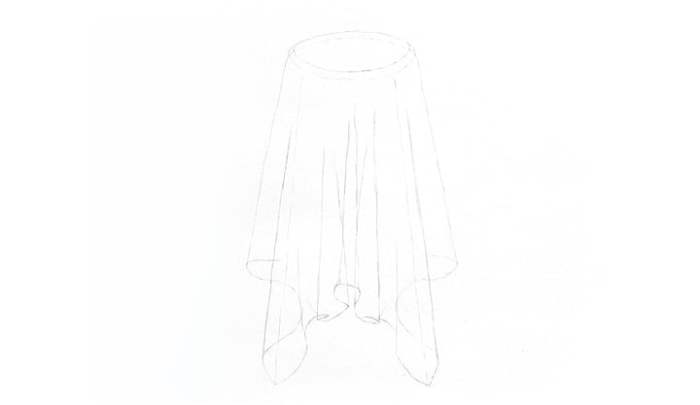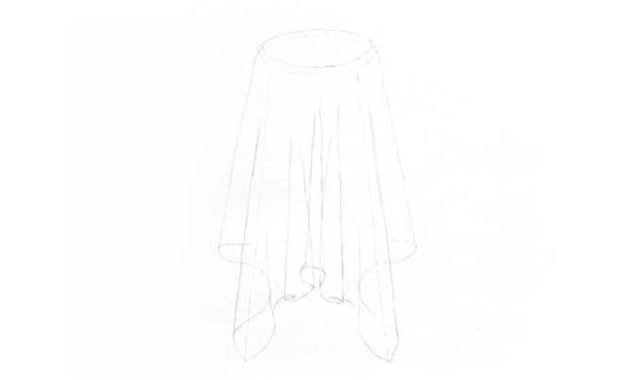Defining “Easy Drawing of Silk”: A Easy Drawing Of Silk

A easy drawing of silk – An easy drawing of silk focuses on capturing the essence of the fabric’s fluidity and sheen without getting bogged down in intricate details. It’s perfect for beginners who want to learn how to represent texture and movement in their artwork. The goal isn’t photorealism, but rather a suggestive and aesthetically pleasing representation of silk.The simplicity of an easy silk drawing allows artists to concentrate on fundamental drawing skills, such as line control and shading techniques, while still achieving a visually satisfying result.
Capturing the fluidity of silk in a simple drawing requires focusing on the gentle curves and subtle shading. Think about how the light catches the fabric, creating highlights and shadows. For a similar approach to simplified forms, check out this tutorial on 7 dwarfs doc drawing easy , which emphasizes basic shapes to achieve a charming result.
Applying this principle of simplification to your silk drawing will help you create a beautiful, yet uncomplicated piece.
This approach is particularly useful for developing an understanding of how to portray different types of fabrics and their unique qualities.
Basic Shapes and Lines for Representing Silk, A easy drawing of silk
Simple shapes and lines are the building blocks of an easy silk drawing. Smooth, flowing curves are key to conveying the drape and movement of silk. Think of using gentle, sweeping lines to suggest the folds and creases in the fabric. Basic shapes like elongated ovals and soft, irregular circles can be used to define the overall form of the silk garment or piece of fabric.
Straight lines are generally avoided, unless used to represent sharp creases or structured elements within a silk garment. For example, a simple drawing of a silk scarf might utilize a series of overlapping ovals connected by flowing curves to illustrate its draping. A silk dress might be suggested by a series of gently curving vertical lines to indicate the fabric’s fall.
Levels of Detail in Easy Silk Drawings
The level of detail in an easy silk drawing is entirely dependent on the artist’s skill and the desired effect. A minimalist approach might involve only a few lines to suggest the form and texture of the silk. A slightly more detailed drawing could incorporate subtle shading to indicate highlights and shadows, thereby enhancing the sense of depth and volume.
Even in a simple drawing, the careful use of shading can effectively mimic the sheen and reflective qualities of silk. For instance, a very basic drawing might consist of just a few flowing lines to represent the folds of a silk scarf, while a more advanced easy drawing could include subtle shading to highlight the areas where light reflects off the fabric, creating a sense of luminosity.
The key is to maintain simplicity while still capturing the essential characteristics of the material.
Materials and Techniques

Capturing the luxurious fluidity and subtle sheen of silk on paper requires careful consideration of both materials and technique. The right tools will allow you to achieve a convincing representation of this delicate fabric, even with a simple drawing approach. We’ll explore the essential supplies and straightforward techniques that unlock the secrets to drawing realistic silk.
Choosing the right materials is paramount for achieving the desired effect. The subtle gradations of light and shadow that define silk’s texture require tools that allow for both precision and subtle blending.
Essential Materials
A basic set of materials is sufficient for a beginner’s silk drawing. These readily available items will enable you to focus on developing your drawing skills without being overwhelmed by complex tools.
Begin by gathering the following:
- Drawing Paper: Smooth, high-quality drawing paper is ideal. The smoother surface allows for smoother pencil strokes and easier blending. Avoid textured paper, as this will interfere with the smooth appearance of the silk.
- Pencils: A set of graded pencils (e.g., 2H, HB, 2B, 4B) provides a range of tones for shading. Harder pencils (like 2H) are good for light sketching and detail work, while softer pencils (like 4B) are better for creating dark shadows.
- Eraser: A kneaded eraser is highly recommended for its versatility. It allows for precise removal of graphite without damaging the paper, making corrections and blending easier.
- Blending Stump or Tortillon: This tool helps to smoothly blend pencil strokes, creating subtle gradations of tone and a more realistic representation of silk’s sheen.
Simple Drawing Techniques for Silk
The key to successfully depicting silk lies in understanding and employing techniques that emphasize its characteristic smoothness, reflectivity, and drape. These simple techniques, when combined, will bring your silk drawing to life.
Several techniques contribute to achieving a realistic portrayal of silk. These methods allow for the creation of subtle shifts in tone and texture, mimicking the way light interacts with the fabric.
- Layering: Build up your drawing gradually by layering light pencil strokes. This approach allows for better control over tone and avoids harsh lines.
- Blending: Use a blending stump or your finger to gently blend the pencil strokes, creating smooth transitions between light and shadow. This is crucial for capturing the seamless appearance of silk.
- Value Variation: Use a range of pencil grades to create a variety of tones. This will help you create the subtle variations in light and shadow that give silk its characteristic depth.
Step-by-Step Guide: Basic Shading Techniques
This step-by-step guide will demonstrate how to create a simple silk drawing using basic shading techniques. The focus is on achieving a realistic representation of the fabric’s smooth texture and subtle sheen.
Let’s begin with a simple draped piece of silk:
- Sketching: Lightly sketch the basic shape of the silk fabric using a 2H pencil. Keep the lines light and flowing to capture the graceful drape of the material. Think about how the fabric folds and falls.
- Initial Shading: Using a 2B pencil, begin shading the areas that are furthest from the light source. Apply light, even strokes, building up the tone gradually.
- Adding Depth: Gradually increase the darkness of the shading in the deepest recesses of the folds. Use a 4B pencil for these darker areas. Remember to leave some areas completely un-shaded to represent highlights.
- Blending: Use a blending stump or your finger to gently blend the pencil strokes, creating smooth transitions between the light and dark areas. Focus on the areas where the fabric folds to create a more realistic effect.
- Refining Highlights: Carefully refine the highlights by leaving small, un-shaded areas where the light would naturally reflect off the silk. This will add a sense of luminosity to your drawing.
Popular Questions
What type of pencils are best for drawing silk?
Graphite pencils ranging from H2 (hard) to 2B (soft) offer versatility for achieving different levels of detail and shading.
How do I create a realistic sheen on silk?
Use light, directional strokes to suggest highlights and strategically place darker values in the folds and shadows to create a sense of depth and luminosity.
Can I use other mediums besides pencils to draw silk?
Yes, charcoal, pastels, and even watercolors can effectively capture the texture and sheen of silk. Experiment to find your preferred medium.
How can I practice drawing silk effectively?
Start with simple shapes and gradually increase complexity. Practice observing real silk fabrics, paying attention to the way light interacts with its surface.

